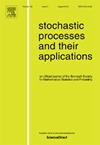出生-死亡过程的近似
IF 1.2
2区 数学
Q3 STATISTICS & PROBABILITY
引用次数: 0
摘要
生灭过程是一种特殊类型的连续时间马尔可夫链状态空间以最小的N .它的分解的矩阵可以完全由一组特征参数(γ、β,ν)、γ和β非负常数,和ν是联合国的积极措施采用Ray-Knight紧化,生灭过程可以实现作为cadlag进程拥有强大一点紧化上的马尔可夫属性空间N¯∂,其中包括一个额外的墓地∂点。在一定意义上,决定生灭过程的三个参数分别对应于其在∞处用于一点紧化的杀死、反射和跳跃行为。一般来说,对出生-死亡过程的轨迹进行清晰描述,特别是在|ν|=∞的病理情况下,是一项挑战。本文旨在通过使用近似方法研究出生-死亡过程来解决这一问题。具体来说,我们将用更容易理解的更简单的出生-死亡过程来近似出生-死亡过程。对于两种典型的近似方法,我们的主要结果建立了由近似过程引起的一系列概率测度在所有càdlàg函数空间上的弱收敛性。这种收敛性明显强于连续时间马尔可夫链理论中典型考虑的转移矩阵的收敛性。本文章由计算机程序翻译,如有差异,请以英文原文为准。
Approximation of birth–death processes
A birth–death process is a special type of continuous-time Markov chains with minimal state space . Its resolvent matrix can be fully characterized by a set of parameters , where and are non-negative constants, and is a positive measure on . By employing the Ray-Knight compactification, the birth–death process can be realized as a càdlàg process with strong Markov property on the one-point compactification space , which includes an additional cemetery point . In a certain sense, the three parameters that determine the birth–death process correspond to its killing, reflecting, and jumping behaviors at used for the one-point compactification, respectively.
In general, providing a clear description of the trajectories of a birth–death process, especially in the pathological case where , is challenging. This paper aims to address this issue by studying the birth–death process using approximation methods. Specifically, we will approximate the birth–death process with simpler birth–death processes that are easier to comprehend. For two typical approximation methods, our main results establish the weak convergence of a sequence of probability measures, which are induced by the approximating processes, on the space of all càdlàg functions. This type of convergence is significantly stronger than the convergence of transition matrices typically considered in the theory of continuous-time Markov chains.
求助全文
通过发布文献求助,成功后即可免费获取论文全文。
去求助
来源期刊

Stochastic Processes and their Applications
数学-统计学与概率论
CiteScore
2.90
自引率
7.10%
发文量
180
审稿时长
23.6 weeks
期刊介绍:
Stochastic Processes and their Applications publishes papers on the theory and applications of stochastic processes. It is concerned with concepts and techniques, and is oriented towards a broad spectrum of mathematical, scientific and engineering interests.
Characterization, structural properties, inference and control of stochastic processes are covered. The journal is exacting and scholarly in its standards. Every effort is made to promote innovation, vitality, and communication between disciplines. All papers are refereed.
 求助内容:
求助内容: 应助结果提醒方式:
应助结果提醒方式:


